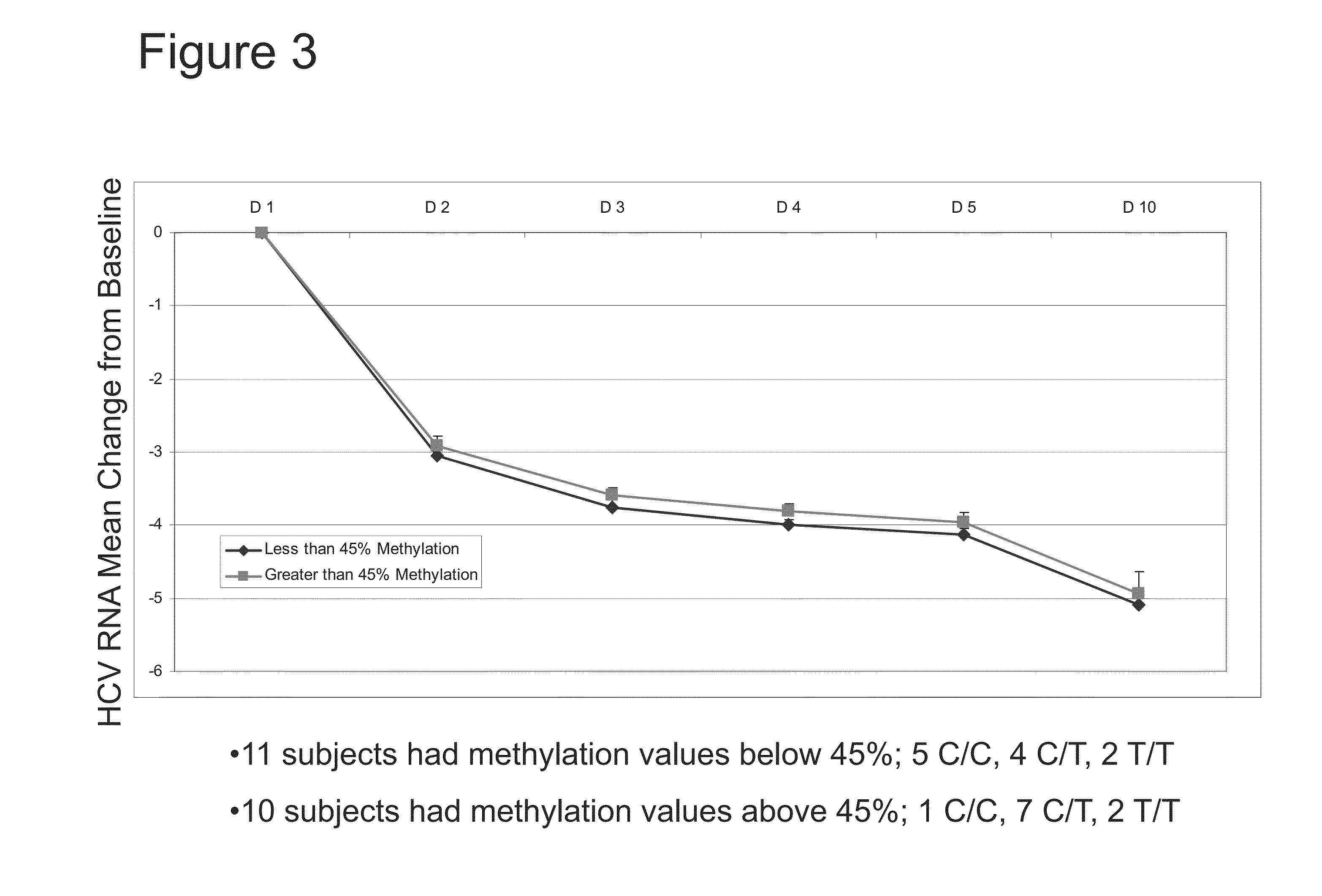Methods for treating hcv
a technology of hepatitis c virus and treatment method, which is applied in the direction of microorganism testing/measurement, biochemistry apparatus and processes, organic active ingredients, etc., can solve the problems of insufficient viral elimination from the body, substantial limitations in efficacy and tolerability, etc., and achieve the effect of improving the pharmacokinetics and bioavailability of the therapeutic agent 1
- Summary
- Abstract
- Description
- Claims
- Application Information
AI Technical Summary
Benefits of technology
Problems solved by technology
Method used
Image
Examples
example 1
Percent Methylation in Three CpG Islands in the IL28B Promoter in Treatment-Naïve and Treatment-Experienced HCV-Infected Patients
[0096]Treatment-naïve patients and treatment-experienced patients were included in the study. The treatment-experienced patients previously received peg-interferon and ribavirin (“SOC”), but did not achieve an adequate sustained response. Subjects included 30 treatment-naïve subjects and 14 treatment-experienced subjects between the ages of 18 and 65.
[0097]DNA samples were analyzed for methylation in three CpG islands in the IL28B promoter. The three CpG islands correspond to SEQ ID NO:1 (PM-01), SEQ ID NO:2 (PM02), and SEQ ID NO:3 (PM03).
[0098]As shown in FIG. 1, analysis of the three CpG islands in the IL28B promoter suggests that subjects who failed SOC treatment as a group may have higher methylation levels in two of three islands. The higher methylation levels may repress expression of the IL28B gene.
example 2
Methylation Status of IL28B PM-02 and Response to SOC after 10 Days of SOC Treatment
[0099]Eleven (11) treatment-naïve patients were included in the study. The patients received peg-interferon and ribavirin (“SOC”) for ten (10) days.
[0100]DNA samples obtained prior to the initiation of SOC treatment were analyzed for methylation in a CpG island in the IL28B promoter corresponding to SEQ ID NO:2 (PM02). Subjects were grouped based on methylation level of PM02. Six (6) subjects had methylation values below 45% (squares). Five (5) subjects had methylation values above 45% (diamonds).
[0101]Viral load was assessed on Day 1 (“D1”), Day 2 (“D2”), Day 3 (“D3”), Day 4 (“D4”), Day 5 (“D5”), and Day 10 (“D10”) of treatment. As shown in FIG. 2, the subjects having methylation values less than 45% showed a dramatic reduction in viral load after 10 days of SOC treatment. Conversely, the subjects having methylation values greater than 45% showed minimal reduction in viral load after 10 days of SOC ...
example 3
Methylation Status of IL28B PM-02 and Response to Compound 1 after 10 Days of Treatment
[0102]Twenty-one (21) treatment-naïve patients were included in the study. The patients received Compound 1 and ritonavir for three days followed by the addition of peginterferon and ribavirin for a total of 12 weeks of combination treatment.
[0103]DNA samples obtained prior to the initiation of treatment were analyzed for methylation in a CpG island in the IL28B promoter corresponding to SEQ ID NO:2 (PM02). Subjects were grouped based on methylation level of PM02. Eleven (11) subjects had methylation values below 45% (diamonds). Ten (10) subjects had methylation values above 45% (squares).
[0104]Viral load was assessed on Day 1 (“D1”), Day 2 (“D2”), Day 3 (“D3”), Day 4 (“D4”), Day 5 (“D5”), and Day 10 (“D10”) of treatment. As shown in FIG. 3, both groups showed a dramatic reduction in viral load after 10 days of treatment. This analysis suggests that methylation status of the CpG island of the IL28...
PUM
| Property | Measurement | Unit |
|---|---|---|
| frequency | aaaaa | aaaaa |
| frequencies | aaaaa | aaaaa |
| time | aaaaa | aaaaa |
Abstract
Description
Claims
Application Information
 Login to View More
Login to View More - R&D
- Intellectual Property
- Life Sciences
- Materials
- Tech Scout
- Unparalleled Data Quality
- Higher Quality Content
- 60% Fewer Hallucinations
Browse by: Latest US Patents, China's latest patents, Technical Efficacy Thesaurus, Application Domain, Technology Topic, Popular Technical Reports.
© 2025 PatSnap. All rights reserved.Legal|Privacy policy|Modern Slavery Act Transparency Statement|Sitemap|About US| Contact US: help@patsnap.com



